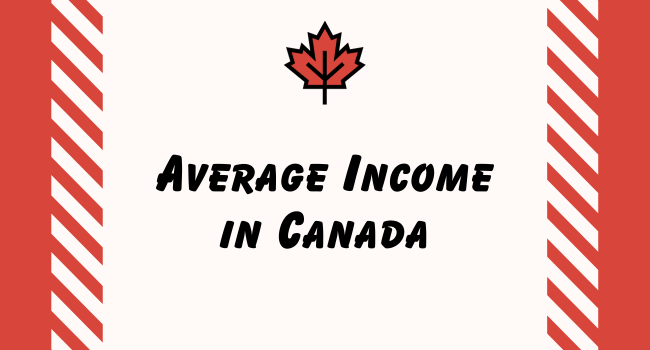Canada is a vast country with a diverse population, and one of the most interesting aspects to explore is the variation in income levels across different provinces and territories. Understanding the average income in various regions can provide valuable insights for individuals and families looking to relocate, businesses considering expansion, or anyone interested in the economic health of Canada.
In this post, we’ll break down the average income across all states (provinces and territories) in Canada and highlight key factors influencing income levels. This information can help you make more informed decisions about where to live, work, or invest.
What Is Average Income?
Average income refers to the total income earned by all residents of a particular area divided by the number of individuals or households in that region. It gives a general idea of the financial well-being of a population. Factors such as industry presence, job opportunities, cost of living, and education levels can influence the average income in any given province or territory.
Factors Influencing Average Income in Canada
Before diving into the specifics of each province, it’s important to understand what drives income variations across Canada:
- Industry Presence: Provinces with stronger industrial sectors, such as oil, gas, and technology, tend to have higher average incomes due to higher-paying jobs.
- Cost of Living: Higher costs of living, especially in large cities like Toronto and Vancouver, can push wages up.
- Education Levels: Provinces with more highly educated populations tend to have a higher average income, as educated individuals typically qualify for higher-paying jobs.
- Urban vs. Rural: Urban areas tend to have higher incomes due to better job opportunities and higher-paying industries.
- Government Policies: Tax structures, minimum wage laws, and other government policies can also impact the overall average income in different provinces.
Now, let’s explore the average income across the provinces and territories of Canada.
1. Ontario
As Canada’s most populous province, Ontario boasts a diverse economy, with sectors like technology, finance, and manufacturing playing key roles.
- Average income in Ontario is around CAD $55,000 per year.
- Major cities like Toronto and Ottawa offer higher-than-average wages, but the cost of living can offset this advantage.
For more details, check out this comprehensive guide on the average income in Canada.
2. Quebec
Quebec has a rich history, strong cultural identity, and a growing economy, particularly in technology and manufacturing.
- The average income in Quebec is about CAD $50,000 annually.
- Montreal, the province’s largest city, is a hub for tech and creative industries, offering higher incomes in these sectors.
3. British Columbia
With its stunning natural beauty and strong economy, British Columbia is a popular destination for both Canadians and immigrants.
- The average income in British Columbia is approximately CAD $53,000 per year.
- Vancouver, the largest city, is known for its high cost of living, but the job market offers opportunities in industries like film, technology, and finance.
4. Alberta
Alberta is one of Canada’s wealthiest provinces, primarily due to its oil and gas industry. While recent years have seen fluctuations in oil prices, the province remains an economic powerhouse.
- Alberta’s average income stands at around CAD $61,000 annually, making it one of the highest in the country.
- Cities like Calgary and Edmonton offer competitive salaries, particularly in the energy sector.
5. Manitoba
Manitoba is known for its agriculture, manufacturing, and transportation sectors. It offers a lower cost of living compared to many other provinces.
- The average income in Manitoba is about CAD $48,000 per year.
- Winnipeg, the provincial capital, is the economic hub with job opportunities in various industries.
6. Saskatchewan
Like Alberta, Saskatchewan benefits from its natural resources, particularly in agriculture and mining. However, it is also developing its tech and finance sectors.
- The average income in Saskatchewan is roughly CAD $52,000 annually.
- The province has seen a rise in tech jobs, which are helping to boost overall wages.
7. Nova Scotia
Nova Scotia has a growing economy, particularly in the service and education sectors. However, it still has one of the lower average incomes in Canada.
- The average income in Nova Scotia is about CAD $46,000 per year.
- Halifax, the capital city, is a center for education and healthcare, providing some of the province’s best-paying jobs.
8. New Brunswick
New Brunswick is a province with a smaller economy, largely focused on agriculture, manufacturing, and services.
- The average income in New Brunswick is around CAD $45,000 annually.
- Saint John and Fredericton are the economic centers of the province, offering job opportunities in various sectors.
9. Prince Edward Island
As Canada’s smallest province, Prince Edward Island has a modest economy driven by agriculture, fishing, and tourism.
- The average income in Prince Edward Island is approximately CAD $44,000 per year.
- Charlottetown, the capital, has a growing tech sector that is beginning to offer higher-paying jobs.
10. Newfoundland and Labrador
Newfoundland and Labrador, historically reliant on fishing, have diversified their economy to include energy and natural resources.
- The average income here is about CAD $50,000 annually.
- St. John’s, the provincial capital, is home to a burgeoning oil and gas industry.
11. Yukon
Yukon, one of Canada’s northern territories, has a small population but a robust economy thanks to mining and government employment.
- The average income in Yukon is approximately CAD $60,000 per year.
- Whitehorse, the capital, is the main economic hub with opportunities in various sectors.
12. Northwest Territories
The Northwest Territories have one of the highest average incomes in Canada, largely due to mining and resource extraction industries.
- The average income here is around CAD $72,000 annually.
- Yellowknife, the capital, has a strong job market in the mining and government sectors.
13. Nunavut
Nunavut is the newest and most sparsely populated territory in Canada. While it has a high cost of living due to its remote location, its wages are also high.
- The average income in Nunavut is about CAD $65,000 annually.
- The economy is based on mining, construction, and public administration.






